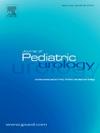表观遗传学在尿道下裂病因学中的可能作用
IF 2
3区 医学
Q2 PEDIATRICS
引用次数: 0
摘要
导言尿道下裂是一种常见的泌尿生殖系统畸形,其发病机制可能与遗传和环境因素之间复杂的相互作用有关。本研究旨在探讨性激素、FGFR2、FGF8 和 BMP7 的受体基因表达以及这些基因的 DNA 甲基化作为表观遗传学标记,可能在尿道下裂的病因中发挥作用。结果发现尿道下裂组中ESR1、FGFR2和BMP7基因表达量显著升高,而AR基因表达量较低。讨论近期的临床研究表明,表观遗传修饰可能在生殖器发育过程中起着重要作用,可能是尿道下裂的病因之一。我们最近的研究表明,尿道下裂患者与对照组的包皮 AR、ESR1 和 FGFR2 基因表达存在明显差异。为了解决这个问题,本研究调查了尿道下裂患者这些相同基因的 DNA 甲基化水平,假设表观遗传修饰可能是观察到的基因表达变化的原因。我们再次观察到尿道下裂患者的 AR、ESR1 和 FGFR2 基因表达异常。结论我们的研究表明,性激素受体基因(ESR1 和 AR)、FGFR2 和 FGF8 的 DNA 甲基化发生了显著变化,这与尿道下裂病例中这些基因的异常表达有关。这些发现表明表观遗传修饰在尿道下裂病因学中的潜在作用。各组基因表达和 DNA 甲基化率的比较.空细胞空细胞基因表达(均值±标度)p 值DNA 甲基化(均值±标度)p 值ESR-1尿道下裂1.79±1.110.00111.1±5.780.001对照1.07±0.746.26±4.91AR尿道下裂2.36±0.980.0013.33±0.870.001对照组4.19±12.185.31±3.64FGFR-2尿道炎0.77±0.560.0013.79±0.960.001对照组0.62±0.472.89±0.52FGF-8Hypospadias2.81±5.85>0.0518.93±5.530.001Control1.86±2.6926.19±4.7BMP-7Hypospadias2.45±6.320.0014.92±1.220.676本文章由计算机程序翻译,如有差异,请以英文原文为准。
The possible role of epigenetics in the etiology of hypospadias
Introduction
Hypospadias is a common malformation of the genitourinary system and is thought with a complex interplay between genetics and environmental factors likely contributing to its pathogenesis. This study aimed to investigate the receptor gene expressions of sex hormones, FGFR2, FGF8 and BMP7 and DNA methylations in these genes as an epigenetic mark, which may play a role in the etiology of hypospadias.
Material and methods
The samples from the foreskin of 20 patients with hypospadias and 20 healthy children who underwent circumcision operations were collected. AR, ESR1, FGF8, FGFR2 and BMP7 gene expressions and DNA methylation rates of these genes were investigated in tissues.
Results
While ESR1, FGFR2 and BMP7 gene expressions were found to be significantly higher in the hypospadias group, AR gene expression was found to be lower. In the hypospadias group, DNA methylation rates were found to be significantly higher in the ESR1, FGF8 and FGFR2 genes, but lower in the AR gene (Table).
Discussion
Recent clinical studies suggest that epigenetic modifications may play a significant role in genital development, potentially contributing to the etiology of hypospadias. Our recent study demonstrated significant differences in foreskin AR, ESR1, and FGFR2 gene expression between patients with hypospadias and controls. To address this, the present study investigated DNA methylation levels of these same genes in hypospadias patients, hypothesizing that epigenetic modifications might be responsible for the observed gene expression changes. We again observed abnormalities in AR, ESR1, and FGFR2 gene expression in hypospadias patients. Furthermore, we found that DNA methylation patterns associated with these genes differed significantly between hypospadias and control groups.
Conclusions
Our study demonstrates significant alterations in DNA methylation of sex hormone receptor genes (ESR1 and AR), FGFR2, and FGF8, which correlate with abnormal expression of these genes in hypospadias cases. These findings suggest a potential role for epigenetic modifications in hypospadias etiology.
Summary table. Comparison of gene expressions and DNA methylation rates of groups.
| Empty Cell | Empty Cell | Gene Expression (Mean ± SD) | p value | DNA Methylation (Mean ± SD) | p value |
|---|---|---|---|---|---|
| ESR-1 | Hypospadias | 1.79 ± 1.11 | 0.001 | 11.1 ± 5.78 | 0.001 |
| Control | 1.07 ± 0.74 | 6.26 ± 4.91 | |||
| AR | Hypospadias | 2.36 ± 0.98 | 0.001 | 3.33 ± 0.87 | 0.001 |
| Control | 4.19 ± 12.18 | 5.31 ± 3.64 | |||
| FGFR-2 | Hypospadias | 0.77 ± 0.56 | 0.001 | 3.79 ± 0.96 | 0.001 |
| Control | 0.62 ± 0.47 | 2.89 ± 0.52 | |||
| FGF-8 | Hypospadias | 2.81 ± 5.85 | >0.05 | 18.93 ± 5.53 | 0.001 |
| Control | 1.86 ± 2.69 | 26.19 ± 4.7 | |||
| BMP-7 | Hypospadias | 2.45 ± 6.32 | 0.001 | 4.92 ± 1.22 | 0.676 |
求助全文
通过发布文献求助,成功后即可免费获取论文全文。
去求助
来源期刊

Journal of Pediatric Urology
PEDIATRICS-UROLOGY & NEPHROLOGY
CiteScore
3.70
自引率
15.00%
发文量
330
审稿时长
4-8 weeks
期刊介绍:
The Journal of Pediatric Urology publishes submitted research and clinical articles relating to Pediatric Urology which have been accepted after adequate peer review.
It publishes regular articles that have been submitted after invitation, that cover the curriculum of Pediatric Urology, and enable trainee surgeons to attain theoretical competence of the sub-specialty.
It publishes regular reviews of pediatric urological articles appearing in other journals.
It publishes invited review articles by recognised experts on modern or controversial aspects of the sub-specialty.
It enables any affiliated society to advertise society events or information in the journal without charge and will publish abstracts of papers to be read at society meetings.
 求助内容:
求助内容: 应助结果提醒方式:
应助结果提醒方式:


